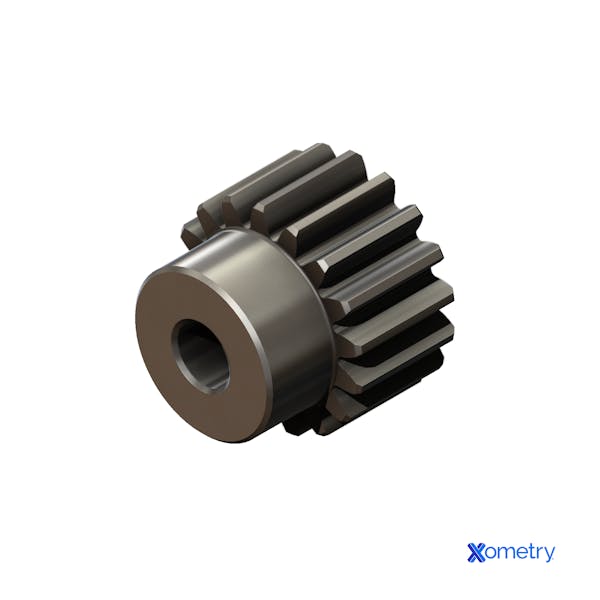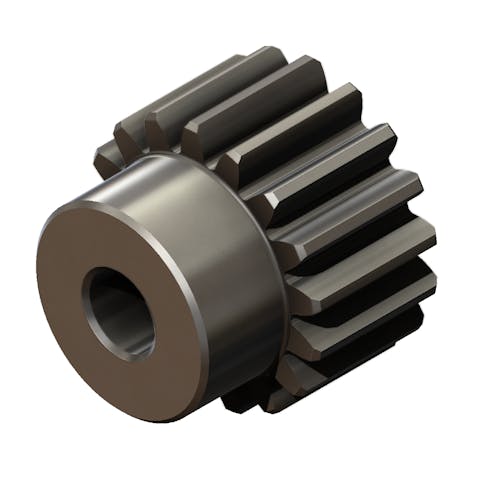With the right mixing and matching of elements, chemistry makes it possible for us to create variants of different materials, taking away certain properties and improving or increasing others. You could say that medium-carbon steel is the Goldilocks of the carbon steel world, in this regard, striking the perfect balance between high- and low-carbon steel.
This ultra-versatile alloy is what many Xometry customers need when they're part of an industry with machinery, parts, and tools that see immense wear and tear. We've seen everything from axles to gears to train wheels and other load-bearing objects that are made with this specific alloy. If you’re intrigued by this steel and how its properties differ from other alloys and metals out there, you can learn more below.
What is Medium-Carbon Steel?
Medium-carbon steel is made up of iron and a slew of other alloying elements, and in some places, you’ll hear it referred to as M2 steel. A closer look at its makeup and you’ll see that its carbon concentration ranges between 0.30% and 0.60% and its manganese between 0.60% and 1.65%. With a serious microscope or instrument, you could see M2’s atomic structure, which features a crystalline lattice of iron atoms with carbon and manganese atoms mixed in.

Chemical Composition
Iron is the main ingredient in medium-carbon steel, but you’ll see in its chemical composition that it also features 0.30% to 0.60% carbon. You may find in certain types that other elements are in the mix, such as silicon, phosphorus, sulfur, chromium, and nickel.
The table below shows you the different composition percentages of all the chemical elements that typically make up medium-carbon steel.
| Chemical Element | Percentage composition |
|---|---|
Chemical Element Carbon (C) | Percentage composition 0.3%–0.6% |
Chemical Element Manganese (Mn) | Percentage composition 0.6%–1.65% |
Chemical Element Sulfur (S) | Percentage composition 0.05 |
Chemical Element Phosphorus (P) | Percentage composition 0.04 |
Chemical Element Chromium (Cr) | Percentage composition 0.80–1.10 |
Chemical Element Copper (Cu) | Percentage composition 0.08 |
Chemical Element Vanadium (V) | Percentage composition 0.51 |
Chemical Element Nickel (Ni) | Percentage composition 0.15 |
Chemical Element Molybdenum (Mo) | Percentage composition 1.61 |
Chemical Element Iron | Percentage composition Balance |
Characteristics and Properties of Medium-Carbon Steel
There are a few things that make medium-carbon steel a notable material, and specific traits that you may find useful for manufacturing. Medium-carbon steel is known to be strong but also ductile, and it’s perfectly fine holding its own when you heat treat it. It has no problem dealing with harsh environments and the wear and tear that comes with them. Our machinists enjoy working with it over some other types of steel due to its relative machinability. The tables below will give you more specifics on the physical and thermal properties of medium-carbon steel.
| Property | Value |
|---|---|
Property Yield Strength | Value 420 Mpa |
Property Hardness | Value 200 MPa |
Property Density | Value 7.75–7.89 g/cm³ |
Property Magnetism | Value It is typically magnetic |
| Thermal Property | Value |
|---|---|
Thermal Property Thermal Conductivity | Value 45 W/(m·K) |
Thermal Property Specific Heat Capacity | Value 0.470–0.519 J/g-°C |
Thermal Property Coefficient of Thermal Expansion | Value 10.8 x 10-6/°C |
How It’s Made
Like other forms of carbon steel, you’ll find that medium-carbon steel is made through the usual steel production process. What varies is how much carbon gets introduced into the alloy. With steelmaking, iron ores are mined and then broken down into iron and oxygen in a blast furnace, the former being the important part for steel. Once this happens, other elements can be thrown into the mix. To hit that medium-carbon sweet spot, a percentage between 0.30% and 0.60% carbon content is targeted. After the alloy is created, it is refined and shaped into various forms.
Different Types of Medium-Carbon Steel
When we refer to a material as a medium-carbon steel, it's actually more of a term that includes all types of alloys that fall under its umbrella. There are several variations that differ in carbon content, but are all considered medium-carbon steels:
1. 4140 Steel
One of Xometry's most popular medium-carbon steel alloys is 4140. This chromium-molybdenum alloy will have between 0.38% and 0.43% carbon content and is superb if you need steel that welds well. Because 4140 steel also has a high-wear resistance and remains strong in extremely cold temperatures, it may be a material you consider for things such as hydraulic cylinders, shafts, and other heavy machinery parts.
2. 1060 Steel
With 1060 steel, you’re getting a material with slightly higher carbon content, coming in at around 0.60%. It’s relatively brittle, especially in comparison to 1045, but it’s ideal if you need hard blades and knives for machinery and tools.
3. 1045 Steel
As indicated by its name, you’ll find 1045 steel has 0.45% carbon content. When machining it, you’ll notice it’s much more easily weldable and workable than 1060 or 4140, but it doesn’t possess the same corrosion- and wear-resistance as other versions. It’s a smart choice if you’re wanting to make sprockets, gears, axles, and shafts. Xometry offers various finishing solutions, such as black oxide or powder coating, that can help protect or enhance the surface of this material.
Common Forms
Aside from selecting between different types of medium-carbon steel, you can also choose from several formats:
1. Bars
Medium-carbon steel bars can come in both cylindrical and rectangular shapes and offer high strength, which is perfect if you’re manufacturing heavy-duty shafts, axles, and gears. You’ll also find that pearlite and ferrite are often blended into the mix of these steel bars for added robustness. We often use bar stock for CNC-machined components.
2. Sheets
We often work with sheets of medium-carbon steel, which are great when constructing automotive panels and other structural components that need to be molded, formed, machined, or welded. These will also have certain levels of pearlite and ferrite in their makeup.
3. Wire
The wire format of medium-carbon steel is exceptionally made if you’re interested in creating springs, cables, and other products that require a robust finish but are still machinable. Even under strain, you can bend, twist, and form these wires while maintaining their tensile strength.
Applications and Uses of Medium-Carbon Steel
There are many ways you can use and form medium-carbon steel, especially when you need parts and components that can handle heavy loads without breaking. Here are a few part examples and applications we've seen with our customers:
- Railway tracks
- Train wheels
- Couplings
- Forgings
- Crankshafts for engines
- Machinery parts
- Automotive panels
- Springs
- Cables
- Gears

| Country | Equivalent Name |
|---|---|
Country United States | Equivalent Name AISI 1045 |
Country European Union | Equivalent Name C45E |
Country Germany | Equivalent Name 1.1191 (Ck45) |
Country Japan | Equivalent Name S45C |
Country China | Equivalent Name 45# or 45G |
Advantages and Disadvantages
When you’re working out whether or not to incorporate medium-carbon steel into your project or facility, it’s worth understanding the main advantages and disadvantages.
Advantages
- Heat-treatable: You can heat-treat medium-carbon steel to boost its hardness and strength without risking its integrity. This is a standard finishing option we offer for parts made from these alloys.
- Weldability: With a melting point of 1,500°C, this is a plus if you’re interested in welding with this kind of steel.
- Machinable: If you’re interested in creating complex parts, you can rely on medium-carbon steel and its good machinability. Better machinability can also help reduce time on the machine and lower part costs.
- Durable: When you’re parts require wear resistance and the ability to handle heavy loads, this material is well suited for the job.
Disadvantages
- Brittleness: Medium-carbon steel is far more brittle than some other metals, especially when you heat it to a particular temperature, so it’s best to heat-treat it properly.
- Rusts easily: One downfall of medium-carbon steel is that it can rust quickly, but fortunately, you can fend off most rust if you choose to apply protective coatings, such as our powder coating option.
- High cost: Because there are other alloying elements in medium-carbon steel, you’ll notice it’s more expensive than low-carbon steels.
Medium-Carbon Steel vs. High or Low-Carbon Steel
As you might have guessed, medium-carbon steel sits right between high-carbon steel and low-carbon steel and is a great happy medium for many applications because of this. In comparison, you’ll see that high-carbon steel has a slightly higher percentage of carbon content (0.60% to 1.5% in comparison to medium-carbon steel’s 0.30% to 0.60%) and is even more brittle. When you look at low-carbon steel, you’ll notice it has a lower carbon content (up to 0.30%) but is not as strong as the other two. Still, it is cheaper and more malleable, if that’s something you’re after.
Medium-Carbon Steel vs. Stainless Steel
Interestingly, stainless steel comes from a mix of medium- and low-carbon steel, and is best if you like the properties of carbon steel save for the poor rust and corrosion resistance. The main difference you’ll discover is that stainless steel is processed and alloyed in such a way that makes it better capable of handling environments where moisture and oxygen can ruin its integrity.
Medium-carbon steel is a unique blend of carbon and alloying elements that’s worth exploring as an option when you’re in search of materials that can handle extreme wear and tear and heavy-duty loads.
How Xometry Can Help
At Xometry, we offer dozens of materials, including medium-carbon steels, for custom machined, sheet cut, and bent parts. If you're concerned about the aforementioned downside of rust or corrosion, we have finishing options to address that. Best of all this can all be automatically quoted with the Xometry Instant Quoting Engine®.
You can get your instant quote today by uploading your 3D CAD file. You'll find medium-carbon steel alloys such as 4140 and 1045 in our CNC and sheet cutting services, respectively.
Disclaimer
The content appearing on this webpage is for informational purposes only. Xometry makes no representation or warranty of any kind, be it expressed or implied, as to the accuracy, completeness, or validity of the information. Any performance parameters, geometric tolerances, specific design features, quality and types of materials, or processes should not be inferred to represent what will be delivered by third-party suppliers or manufacturers through Xometry’s network. Buyers seeking quotes for parts are responsible for defining the specific requirements for those parts. Please refer to our terms and conditions for more information.


